Nivola & New York
From the Olivetti Showroom to the Unbelievable City
April 15–July 15, 2022
Via Gonare no. 2
08026 Orani NU
Italy
Curated by Giuliana Altea, Antonella Camarda, Luca Cheri, Carl Stein.
Costantino Nivola, a leading figure in 20th-century Italian sculpture and graphic design, was a key figure in relations between Italy and America. Exiled in the United States as an anti-fascist, he began a career creating “sculpture for architecture,” working with the great masters of modernism. In 1954, his bas-relief for the Olivetti showroom in New York marked the start of the success of Italian production in the US.
Nivola’s relationship with New York, the “unbelievable” and “wondrous” city that had welcomed him in 1939 after his escape from Italy, left a profound mark on his work as an artist. Exciting, engaging, and at the same time destabilizing, the New York cityscape is a metaphor for the human condition in the modern and post-modern worlds.
The exhibition centers on Nivola’s relief for the Olivetti Showroom on 5th Avenue, designed by Studio BBPR in 1954, a cornerstone of postwar Italian art and architecture and a symbol of a new approach to business communication.
Measuring 23 meters long and 5 high, the monumental semi-abstract frieze, made using the sandcasting technique, was the central element of an installation evoking the Mediterranean sea. After the store closed in 1969, the sculpture was moved in 1973 to the Harvard Science Center, on request by the architect Josep Lluís Sert.
For this exhibition, a faithful reconstruction was made of the work on a 1:1 scale, using visual computing, 3D printing, and videomapping.
Measuring 101 meters square, it is one of the largest three-dimensional culture heritage reproductions ever made with robotic milling.
“The exhibition,” Giuliana Altea explains, “revolves around this extraordinary relief, which covers an entire museum wall. The reproduction will make it possible to see the details of the sculpture preserved at Harvard and thus not easily accessible by the general public. It was created as part of the digital humanities project Nivola X Olivetti, which involved the collaboration of the Fondazione Nivola with Harvard University and the University of Sassari, the CRS4 – Centro di Ricerca, Sviluppo e Studi Superiori in Sardegna, the ISTI – CNR – Istituto di Scienza e Tecnologie dell’Informazione “Alessandro Faedo”, Pisa, Make in Nuoro, the “fab lab” of the Nuoro Chamber of Commerce, the Archivio Olivetti, Ivreaand the Fondazione Olivetti, Rome.”
If the Olivetti relief was the starting point of Nivola’s career in America, the Combined Police and Fire Facility of 1984 was its terminus. As observed by Carl Stein, who designed the building and was Nivola’s friend, “at the end of his career, the artist chose a narrative, anti-monumental approach, talking about the human side of the police force, putting it in light of civic responsibility and concentrating on episodes of the everyday presence of the State.”
Between these two chapters of Nivola’s New York story, there is the Stephen Wise Recreation Area, a playground in the middle of a housing project on the Upper West Side, where the artist created a large graffito mural, sculptures, a fountain, and a group of small, stylized horses for children to play on. “The Stephen Wise horses,” observes the director Luca Cheri, “are among Nivola’s most successful and joyous creations. After the heated protest triggered by their removal in 2021, they became the symbol of the capacity of Nivola’s art to touch the public.”
The exhibition is completed by a selection of paintings and drawings depicting the chaos and excitement of New York, the urgent flow of city life, and the sense of alienation and disorientation it can create.
“This exhibition,” notes Antonella Camarda, “is the fruit of collaboration between humanists and scientists, and enterprises. In the same spirit of experimentation and constant innovation that characterized Costantino Nivola’s approach and was the distinctive feature of Olivetti.”



